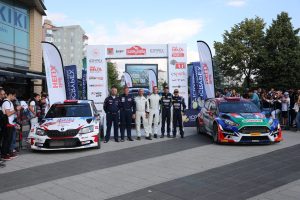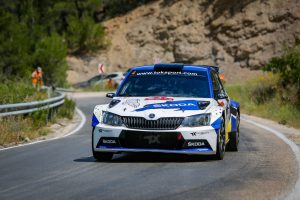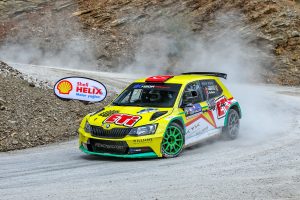[:tr]
1– RALLİ NEDİR?
Modern dünya şampiyonasının kökeni motorlu aracın icadına kadar uzanır. İnsanoğlu her zaman rekabet etme ruhuna sahiptir. A noktasından B noktasına dört tekerlek üzerinde gitme imkânı ortaya çıkınca, birisinin oraya diğerlerinden daha hızlı gitmeyi istemesi kaçınılmazdı! İşte rallinin kendisi de bu: bir yerden başka bir yere dünyadaki diğer herkesten daha hızlı gitmek. Eski günlerde böyle küçük bir oluşum dikkate alındı. Rallilerin çoğu ünlü Londra-Brighton Rally de olduğu gibi belirli mesafeyi en kısa zamanda gidenin galip olduğu yol yarışlarından ibaretti. Şimdi ise ralliler özel etap olarak adlandırılan sıkı bir biçimde kontrol altında tutulan parkurlarda yapılan birbirine bağlı güzergâhlarda düzenlenir. Her ralli içerisinde 2 gün keşif (recce), bir gün otomobillerin son testi için ayrılan deneme sürüşü (shakedown) ve Basın Toplantısı ile yarış kısımları için 3 gün bulundurmalıdır. Ralliler ortalama olarak 15-25 özel etap arasında değişir. Arkasında üreticilerin bulunduğu fabrika takımları her ralliye 2 ya da 3 araçla katılıp, yarışın yapılacağı yere hazırlıklarını yapmak üzere rallinin startından 2 hafta öncesinden gelmeye başlar. Yarışan ralli otomobilleri, sürücüler klasmanı lideri ilk sırada olmak üzere pozisyonlarına göre sıralanırlar ve o şekilde yarışa başlarlar.
Yol Keşfi
Her ralliden önce yarışmacılar etapları tanımak için 2 gün keşif yapma şansına sahiptirler. Bu keşif esnasında pilot ve co-pilotun ralliden önce güzergahı tanımak ve yol notu hazırlamak için kullandıkları ekstra güvenlik ekipmanlı otomobiller organizatör tarafından belirlenen maksimum 50-70 km arasında değişen hız limitine uymak zorundadırlar. Yarışmacıların etaba alışmak ve yol notu çıkarmak için her etabı iki kez geçme hakları vardır.
Etaplar
Özel etaplar yarışmacıların en iyi zamanı elde edebilmek için mümkün olduğunca hızlı bir biçimde geçmeye çalıştıkları, rallinin yarışılan kısımlarını ifade eder. Bu kısımlar ralli esnasında halka kapatılan özel ya da kamu yollarından oluşur. Tipik bir ralli 3 günde koşulmak üzere yaklaşık 15-25 özel etaptan oluşur. Özel etaplar, birbirine normal etap olarak adlandırılan ve tüm yarışmacıların trafik kurallarına uyması gereken halka açık yollarla bağlıdır. Her gün 4’te 3’ü yarışılan özel etaplardan oluşmak üzere 300 kilometre sürüş yapılması söz konusudur. Uzunluğu 5-60 kilometre arasında değişen etaplardaki dereceler saniyenin ondalık kısımlarına kadar kaydedilir. Tüm organizasyon esnasında ise özel etapların toplam uzunluğu 250-350 kilometre arasında olmalıdır.
Zaman
Çizgiyi ilk geçen olmayı’ unutun! Ralli otomobilleri direkt olarak birbirlerine karşı yarışmazlar. En çetin rakip olan zamana karşı yarış vardır. Otomobiller 1 ya da 2 dakika arayla start alarak zamana karşı yarışırlar ve zamanları bilgisayar destekli sonuç sistemi aracılığıyla görüntülenir ve kaydedilir. Eğer otomobillerden biri herhangi bir sorun yaşamazsa rakipler etapta çok seyrek olarak birbirini görürler.
Zaman Kontrol Noktaları
Rallinin izlenecek olan güzergâh kılavuzu sıkı bir zaman çizelgesine tabidir. Sürücüler özel etapların startlarına ve servis alanının giriş çıkışlarına geç ya da çok erken geldiklerinde zaman cezası alırlar. Bu kontrol noktalarına geç gelinen her dakika genellikle 10 saniye zaman cezası ile cezalandırılır ve bu süre yarışmacının genel zamanına eklenir. Bunun yanında zaman kontrol noktasına 30, ayak (gün içinde) için 30, rallinin tümünde 60 dakika geç kalınması sürücünün müsabakadan ihraç edilmesine neden olabilir.
Kazanan nasıl belirlenir?
Her sürücüye start sinyali veriliyor, sinyal bir dizi geri sayım ışığını içeren elektronik sistemden ibaret. Start sinyali verilince yarışmacı etabı mümkün olan en kısa sürede geçmek ve zamanının kaydedileceği “flying finish” olarak adlandırılan hareketli finiş noktasına varmak için hareket eder. Sürücünün finiş noktasını geçtiği andaki zaman saat, dakika, saniye ve salise olarak kaydedilir. Sürücünün saat kaçta start aldığı da kayıt altına alınmış olduğu için bu zamanlar birbirinden çıkarılarak yarışmacının o etapta elde ettiği zaman dakika, saniye ve salise olarak ilgili pilotun hanesine yazılır.
Her etap geçildikçe zamanlar toplanır ve müsabaka sonunda en düşük zamanı elde eden sürücü kazanan olarak ilan edilir. Etaplar arasındaki halka açık olan yollarda, yarışmacılardan bütün kurallara uyarak ilerlemeleri dâhilinde belirlenen zaman aralığı içinde hareket etmeleri istenir. Eğer ekip bu kısımlardan birinde mekanik arıza ya da benzer bir durum sebebiyle geç kalırlarsa, geç kalınan her dakika için 10 saniye zaman cezası alır. Bu ceza zaman cezası olarak adlandırılır ve bu süre yarışmacının hanesine eklenir. Ekiplerin normal etaplarda hız limitlerine uymaması, trafik kurallarına çiğnemekle alınacak cezaların yanında organizasyon tarafından verilecek zaman cezalarından müsabakadan ihraca kadar cezaları gündeme getirebilir. Müsabakanın sonunda ise zaman cezaları da dâhil olmak üzere tüm etap zamanları toplandığında en düşük zamanı elde eden yarışmacı kazanan ilan edilir.
2 – EKİP
Rallide başarının kilit noktası takım olarak hareket eden, otomobilini sorunsuz ve en kısa sürede geri getirmeyi başaran sürücü ve yardımcı sürücünün ortaklığıdır. Eğer gaz pedalı yerde değilse sürücü çok yavaş gidiyordur. Eğer fren pedalı yerde değilse bir yere çarpacaktır. Bir ralli otomobilinin direksiyonunda olmak kolay değildir. Bir ralli otomobiline sahip olmak sizi ralli sürücüsü yapmayacaktır. Tam gaz gitmeden, sürerken ayağınız yerde olmaksızın hiçbir başarı kazanamazsınız. Üst sınıf bir ralli sürücüsü, cesur, teknik ve taktik açıdan maharetli, içgüdüsel birazcık da kaçık olmalıdır. Tutkulu ve yüksek derecede konsantrasyona sahip olup yardımcı sürücüsüne korkusuzca güvenmelidir. Sonra hızlı olmalıdır da. Sürücü ve yardımcı sürücü arasındaki güven mutlak olmalıdır. Siz siste kör olmuşçasına saatte 150 km süratle, sırf ekip arkadaşınız bunun güvenli olduğunu söylediği için kör bir viraja girer misiniz?
Etap boyunca sürücüye kılavuzluk yapmak yardımcı sürücünün görevidir. Ralli öncesindeki keşif esnasında, her virajda yolun yüzeyi, çukurlar, kayalar ve potansiyel tehlikelerle ilgili kapsamlı yol notlarını el yazısıyla yazar. Böylelikle etabı bir bir sonraki geçişlerinde pilotunun hangi hızda dönebileceği konusunda tahmin yapabilmesine olanak tanır. Bu notları, etapta ilerledikçe sürücüsüne okur. Yardımcı sürücüler rallilerin dile getirilmeyen kahramanlarıdır. Servis alanına dönüldüğünde sürücü ön planda olurken, o bir sonraki günün yol notları hazırlıklarına girişir. Fakat her zaman tetikte, kararlı ve sürücüsüne adanmış olmalıdır. İyi bir yol notu okuyucusunun olmaması pilot için ciddi bir engel teşkil eder.
3- SERVIS ALANLARI
Birkaç etaptan oluşan her bölüm tamamlandığında otomobiller, sıkı kontroller altında, belli sürelere bağlı kalınarak tamir ve bakım işlerinin yapıldığı özel olarak bu iş için dizayn edilmiş alanlara gelirler. Otomobil üzerindeki verilerin aktarılmasının yanında lastiklerin değiştirildiği ve ayarların yapıldığı esnada mekanik işlerin de gerçekleştirilmesi için her otomobil üzerinde 6 teknisyenin çalışmasına izin verilir. Servis zamanları zaman çizelgesine göre 10, 30 ve 45 dakika olarak ile sıkı bir şekilde sınırlandırılmıştır.
Her günün sonunda otomobilleri bir sonraki günün startına kadar muhafaza edilecekleri “kapalı park”a alınmadan önce ekiplere 45 dakika ile sınırlanmış tamir ve bakım süresi verilir. Belirlenen süreleri aşan ekiplere ise zaman cezası uygulanır.
Yorucu bir etaptan sonra otomobilin hangi şartlarda servis alanına dönmesi gerektiği konusunda herhangi belirlenmiş bir kural yoktur. Ekipler servis alanına yaklaşırlarken otomobilin durumu hakkında telsiz sayesinde takıma bilgi vererek duruma göre müdahale için hazır olmalarını beklerler.
Otomobili yeniden ralliye hazır hale getirmek için 30 dakikaları vardır. Otomobil takım için ayrılan yere girdikleri andan itibaren süre akmaya başlar. Belirlenen sürenin aşıldığı her saniye için ekibe zaman cezası uygulanır.
Ekip, hızlı, becerikli, verimli ve baskı altında sakin olmalıdırlar.
Normalde, otomobil 4 adet üçgen aparat vasıtasıyla yükseltilir ve kendi konusunda uzman 12 kişi otomobille ilgilenir. Eğer otomobil hasarsız bir şekilde gelmişse rutin olarak lastikler değiştirilir, her cıvata ve vidanın sıkılmış olduğunu ve motor titreşimlerinden dolayı gevşemediğini gözlemlemek için detay kontroller yapılır. Ralli otomobillerinin kara kutusu vasıtasıyla bütün otomobil üzerindeki veriler ve anlık analizler kaydedilir. Darbe emiciler, amortisörler ve sürüş yüksekliği ayarları yapılır, 4 fren diski ve balatasının kontrolleri yapılır. Son olarak, ön cam iyice temizlenir. Buna rağmen hala, karoser hırpalanmış, ön cam parçalanmış, kaput ve süspansiyon hasarlı ise teknisyenlerin önünde daha ciddi bir sorun vardır. Hemen orada otomobilin bir sonraki servis için geri gelebileceğinden emin olunacak çözümler üretilmelidir.
Ellerinde aletlerle çalışan ellerin oluşturduğu koreografi etkileyici bir manzara sunarken bir ralli otomobilinin altında 20 dakikalık zaman periyodu çılgın teknisyenler için çok hızlı geçer. Teknisyenler, ilerleyişlerini gözlemleyen, sorunlu noktaları gözden geçiren ve düzenli olarak saate bakıp dakikaları geri sayan ekip şefinin gözetimi altında çalışırlar.[:en]
1- WHAT IS RALLY?
The origins of modern day rallying coincide with the invention of the motor car.
Humankind has always had a competitive spirit. It was inevitable that as soon as the possibility of moving from A to B on four wheels arose, one person would want to do it faster than the others! That’s what world rallying is; moving from one place to another faster than any other person – in the world.
In the “old days” little regard was taken of where such movement occurred. Many of the original “rallies” were more “road races” such as the famous London to Brighton Rally, where cars were timed over the entire distance and the winner was the competitor with the fastest time.
Things have progressed somewhat and rallies now have a tightly controlled format with specific sections (called “special stages”) being reserved for competition, connected together by road or liaison sections.
Preparations for the hard-fought European Rally Championship begin many months before the first rally of the season. The governing body, the Federation Internationale de l’Automobile (FIA) approves routes, stages and final locations of the 11 rallies around Europe, and passes on a copy of the proposals to the major teams.
Each rally must allow one or two days for the reconnaissance (“recce”), one day for “Shakedown” (final testing of cars) and Media Conference and two or three days for competition. The rally typically has between 15 and 25 special stages. The competing crews are seeded and start the event according to their ranking, with the leader of the drivers’ championship setting off first.
Often there are up to 80 or 90 cars taking part in a rally.
The Recce
Driver and co-driver familiarise themselves with the various stages before the start of the event. They drive each special stage twice in a standard road-car (fitted with extra safety equipment) in the two days preceding the rally. It is here that the co-driver writes detailed pace notes for use on the special stages during competition.
The Stages
The special stages are the competitive sections of the rally – where the drivers and co-driver drive as fast as possible to achieve the quickest time. They take place on private roads or public roads, which are closed to the general public while the rally is in progress. A typical rally will have about 15 to 25 special stages over two or three days. The stages are linked by public roads – called road sections -on which competitors must obey all local traffic laws. Each day contains about 250km of driving – a third of which are the competitive special stages. Stages vary in length from five to 60kms, with the cars’ times being recorded after each stage to the tenth of a second. Over the entire event, the special stage distance must more than 250 km.
The Clock
Forget about ‘first across the line’. Rally cars don’t race directly against each other. They compete against the toughest opponent of all; time. Cars start at one or two minute intervals, racing against the clock, their times monitored and entered into the results system. Unless they run into trouble, rivals rarely see each other during a stage.
The Time Controls
A rally itinerary is governed by a strict timetable. Drivers get time penalties for being late (or early!) to clock in to the start of the special stage and at the entry and exit of service parks. Late arrival at these controls is typically penalised with 10 seconds on every minute over and is added to the overall time of the driver. Drivers can be excluded from a rally if they are 30 minutes late for a time control, 30 minutes late for a leg or 60 minutes for an entire rally.
How is a winner determined?
Each driver is given a starting signal on a set minute, the signal consisting of an electronic countdown involving a series of lights. When the start signal is given, the driver takes off from the start of the special stage and proceeds to drive as quickly as possible to the finish of the stage where, as the car passes the “Flying Finish” at full speed, its finish time is recorded as a time of day (in hours, minutes, seconds and tenths of a second). The driver’s time on the stage is then calculated and expressed in minutes, seconds and tenths of a second.
As each stage is conducted, the driver’s times are accumulated and the winner is the driver at the end of the event with the lowest total time. On the liaison sections (on public roads) crews are given a set amount of time in which to travel these sections, obeying all the speed limits. If the crew is late on one of these sections, because of a mechanical problem or similar, they are penalised at the rate of 10 seconds per minute late. This penalty is added to their total time for the rally and is called a “Road Penalty”. Crews who exceed the posted legal speed limits on the liaison sections not only face the usual civil penalties – the FIA has much harsher penalties which it does not hesitate to impose, and which can involve substantial fines (much larger than civil fines), time penalties and even exclusion from the event. At the end of an event, the driver who has taken the least amount of time (including any road penalties) to complete all the stages is the winner.
2- THE CREW
Pivotal to success in the WRC is the partnership between driver and the co-driver, who work as a team to bring the car home safely in the fastest time. If the accelerator isn’t flat to the floor, a driver’s going too slow. If the brake isn’t flat to the floor, he’s going to crash. It’s not easy sitting behind the wheel of a rally car.
Just having a rally car will not make you a rally driver. Nor will flat-out, foot to the floor driving win you any titles. A top-class rally driver must be instinctive, brave, technically and tactically skilful (and a little bit mad). He must be passionate, precise, concentrated and have unflinching trust in his co-driver. And, he’s got to be quick too. The trust between driver and co-driver has to be absolute. Would you drive over a blind brow at 150kph in the fog, because your partner next to you said it was safe?
It’s the co-driver’s job to ‘guide’ the driver through the course. During the pre-rally recce, he (or she) writes extensive hand-written ‘pace notes’ on every corner, road surface, pothole, rock and potential hazard, so he can predict the speeds at which his driver can take the course the next day. He then reads them out to his driver as they hurtle through the stage. The co-drivers are the unsung heroes of the rallying. More usually it is the driver that hits the headlines, while the co-driver is back at the service park going over his ‘pace notes’ for the next day’s rallying. But he must be just as alert, committed and dedicated as his driver – without a good pace note reader, a driver is severely hindered.
3- SERVICE PARKS
After each group of stages is completed, the cars can visit a designated service park where repairs may be carried out by the teams under strict supervision at pre-determined times during each event. Besides interrogating data from the on-board data systems, changing tyres and making running adjustments, during this time a team of six technicians is allowed to perform mechanical work on each car. The time available is strictly limited, with each stop being either 10, 30 or 45 minutes depending on the itinerary.
At the end of each day the crews are allowed a longer 45-minute period to work on the cars before they are locked away in the guarded ‘parc fermé’ until the following morning’s restart. Crews are punished with time penalties for exceeding these alloted times.
After a gruelling stage, there’s no telling in what condition a car will come back to the service park. The crews, forewarned by radio just minutes before a car might limp home, wait to patch up the injured machine. They have just 20 minutes to make the car rally-worthy again.
As soon as the car enters the team enclosure, the clock starts ticking. Every second over the allotted time could land the team with a time penalty, potentially undoing all the time gained on a fast super stage.
Crews need to be quick, efficient, dextrous and calm under pressure.
Normally, cars are raised on four slim triangular stands and attended to by about 12 technicians, each specialists in their field. If the car comes in relatively unscathed, a routine stop would include a complete change of wheels and tyres, a fluid top-up and a ‘spanner’ check, which ensures every nut and bolt is tight and not loosened by the engine vibration.
The shock absorber, damper and ride-height settings may be adjusted and all four brake discs checked for wear and tear. Last but not least, the windshield is thoroughly cleaned. If, however, the car has struggled in, its bodywork battered, the windshield shattered, the bonnet crumpled and the suspension shot, the technicians have a more serious problem on their hands. Ingenious solutions have to be made up on the spot to ensure the car makes it around the next stage.
The choreographed blur of tool-wielding hands is an impressive sight in and under a rally car and the 20 minutes elapse all too quickly for the frantic technicians. They work under the beady eye of their crew-chief, who monitors their progress, oversees trouble-spots and constantly watches the clock, counting the minutes down in a loud and clear voice.[:]







